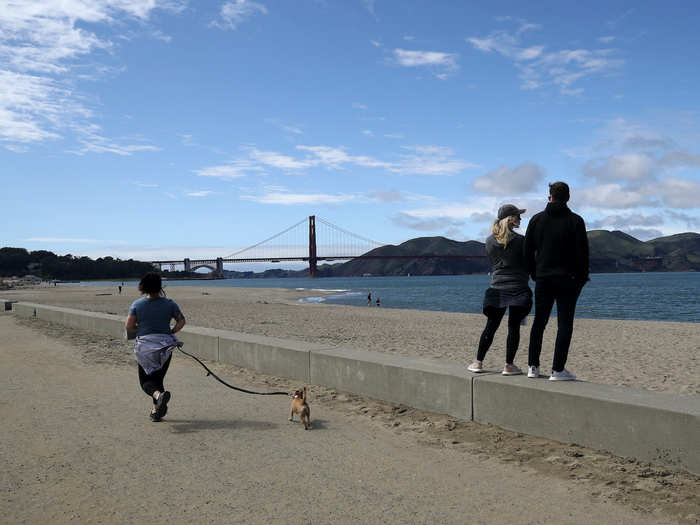
The Bay Area was initially suspected to be the epicenter of the outbreak in the US after the first case of community spread — meaning the source of infection was unknown — was found on the outskirts of the region. Then on March 5, San Francisco's first 2 cases were confirmed, both likely as a result of community transmission.
Even before the shelter-in-place order went into effect on March 17, parts of the Bay Area started prohibiting large gatherings. San Francisco, for example, banned nonessential events exceeding 50 people at city-owned venues. And the region's biggest employers, including tech giants like Apple, Twitter, Facebook, Google, and Salesforce, took early precautions by directing workers to work from home well before the regionwide order went into effect.
"I think we're seeing some early signs that San Francisco seems to be doing something that's working," John Brownstein, an epidemiologist and professor of medicine at Harvard Medical School, told CNBC.

Kaiser Permanente hospitals in Northern California are "seeing a leveling off of Covid-19 cases," Stephen Parodi, an infectious disease doctor and associate executive director with The Permanente Medical Group in Northern California, told Politico. The hospitals have also seen a drop in calls related to colds and coughs since the region began enforcing social distancing.
Jahan Fahimi, medical director of the emergency department at University of California San Francisco's Parnassus campus, told Politico that the shelter-in-place order implemented early on is the most plausible explanation as to why there are fewer cases in the area compared with elsewhere in the US.
"We're definitely cautiously optimistic," Fahimi said. He also said there isn't a surge in patients who need intensive care.
Dr. Bob Wachter, professor and chair of the department of medicine at UCSF, told CNBC on Thursday that the emergency room at UCSF's Parnassus campus is only "moderately busy," with hospital beds still unoccupied in the intensive care unit. According to the CNBC report, the healthcare workers at the hospital have had ample time to prepare for an expected surge in patients — through such measures as postponing surgeries — since the number of critical cases has been climbing at a manageable rate.
San Francisco's California Pacific Medical Center is seeing similar situations.

Alameda County currently has 359 confirmed cases, Contra Costa County has 222, Marin County has 107, San Francisco County has 434, and San Mateo County has 388.
Santa Clara County in the South Bay has seen the highest number of cases with 890 confirmed infections and 30 reported deaths, including the death of a homeless man. Stanford University in Palo Alto has also been hit by the virus, with 33 positive cases according to CNBC. As a result, officials in these areas are less assured than are neighboring county leaders.

New York City has a much denser population than a city like San Francisco, meaning its citizens come into closer contact, creating easier conditions for transmission of the virus.
California as a whole has tested far fewer people compared with the state of New York, as well as with other states. As of last Friday, New York has tested 145,000 people, compared to only 89,600 in California. About 64,000 more California tests are pending, and Gov. Gavin Newsom said Wednesday that the state of California currently has 774 patients in intensive care unit beds, an increase of roughly 17% from Tuesday.
The US as a whole has been grappling with a national shortage of kits for the testing of the coronavirus.

If the enforcement of social distancing is loosened, officials risk an increase in the spread of the virus.
The order extension also brought additional restrictions for residents, like the closure of dog parks, playgrounds, and public picnic areas, and barred funerals from exceeding 10 people.
"We still have plenty of work to do,'' San Jose Mayor Sam Liccardo told Politico. "And one thing I know is that we've got some rough weeks ahead. … This would be far too early for us to be patting ourselves on the back, because we've got very heavy slogging ahead."
 Colon cancer rates are rising in young people. If you have two symptoms you should get a colonoscopy, a GI oncologist says.
Colon cancer rates are rising in young people. If you have two symptoms you should get a colonoscopy, a GI oncologist says. I spent $2,000 for 7 nights in a 179-square-foot room on one of the world's largest cruise ships. Take a look inside my cabin.
I spent $2,000 for 7 nights in a 179-square-foot room on one of the world's largest cruise ships. Take a look inside my cabin. An Ambani disruption in OTT: At just ₹1 per day, you can now enjoy ad-free content on JioCinema
An Ambani disruption in OTT: At just ₹1 per day, you can now enjoy ad-free content on JioCinema In second consecutive week of decline, forex kitty drops $2.28 bn to $640.33 bn
In second consecutive week of decline, forex kitty drops $2.28 bn to $640.33 bn
 SBI Life Q4 profit rises 4% to ₹811 crore
SBI Life Q4 profit rises 4% to ₹811 crore
 IMD predicts severe heatwave conditions over East, South Peninsular India for next five days
IMD predicts severe heatwave conditions over East, South Peninsular India for next five days

Copyright © 2024. Times Internet Limited. All rights reserved.For reprint rights. Times Syndication Service.